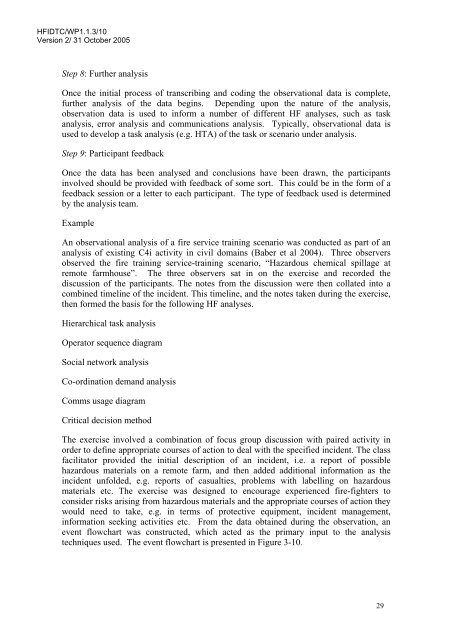A Review of the Event Analysis of Systemic Teamwork Methodology
A Review of the Event Analysis of Systemic Teamwork Methodology
A Review of the Event Analysis of Systemic Teamwork Methodology
- No tags were found...
Create successful ePaper yourself
Turn your PDF publications into a flip-book with our unique Google optimized e-Paper software.
HFIDTC/WP1.1.3/10<br />
Version 2/ 31 October 2005<br />
Step 8: Fur<strong>the</strong>r analysis<br />
Once <strong>the</strong> initial process <strong>of</strong> transcribing and coding <strong>the</strong> observational data is complete,<br />
fur<strong>the</strong>r analysis <strong>of</strong> <strong>the</strong> data begins. Depending upon <strong>the</strong> nature <strong>of</strong> <strong>the</strong> analysis,<br />
observation data is used to inform a number <strong>of</strong> different HF analyses, such as task<br />
analysis, error analysis and communications analysis. Typically, observational data is<br />
used to develop a task analysis (e.g. HTA) <strong>of</strong> <strong>the</strong> task or scenario under analysis.<br />
Step 9: Participant feedback<br />
Once <strong>the</strong> data has been analysed and conclusions have been drawn, <strong>the</strong> participants<br />
involved should be provided with feedback <strong>of</strong> some sort. This could be in <strong>the</strong> form <strong>of</strong> a<br />
feedback session or a letter to each participant. The type <strong>of</strong> feedback used is determined<br />
by <strong>the</strong> analysis team.<br />
Example<br />
An observational analysis <strong>of</strong> a fire service training scenario was conducted as part <strong>of</strong> an<br />
analysis <strong>of</strong> existing C4i activity in civil domains (Baber et al 2004). Three observers<br />
observed <strong>the</strong> fire training service-training scenario, “Hazardous chemical spillage at<br />
remote farmhouse”. The three observers sat in on <strong>the</strong> exercise and recorded <strong>the</strong><br />
discussion <strong>of</strong> <strong>the</strong> participants. The notes from <strong>the</strong> discussion were <strong>the</strong>n collated into a<br />
combined timeline <strong>of</strong> <strong>the</strong> incident. This timeline, and <strong>the</strong> notes taken during <strong>the</strong> exercise,<br />
<strong>the</strong>n formed <strong>the</strong> basis for <strong>the</strong> following HF analyses.<br />
Hierarchical task analysis<br />
Operator sequence diagram<br />
Social network analysis<br />
Co-ordination demand analysis<br />
Comms usage diagram<br />
Critical decision method<br />
The exercise involved a combination <strong>of</strong> focus group discussion with paired activity in<br />
order to define appropriate courses <strong>of</strong> action to deal with <strong>the</strong> specified incident. The class<br />
facilitator provided <strong>the</strong> initial description <strong>of</strong> an incident, i.e. a report <strong>of</strong> possible<br />
hazardous materials on a remote farm, and <strong>the</strong>n added additional information as <strong>the</strong><br />
incident unfolded, e.g. reports <strong>of</strong> casualties, problems with labelling on hazardous<br />
materials etc. The exercise was designed to encourage experienced fire-fighters to<br />
consider risks arising from hazardous materials and <strong>the</strong> appropriate courses <strong>of</strong> action <strong>the</strong>y<br />
would need to take, e.g. in terms <strong>of</strong> protective equipment, incident management,<br />
information seeking activities etc. From <strong>the</strong> data obtained during <strong>the</strong> observation, an<br />
event flowchart was constructed, which acted as <strong>the</strong> primary input to <strong>the</strong> analysis<br />
techniques used. The event flowchart is presented in Figure 3-10.<br />
29
















